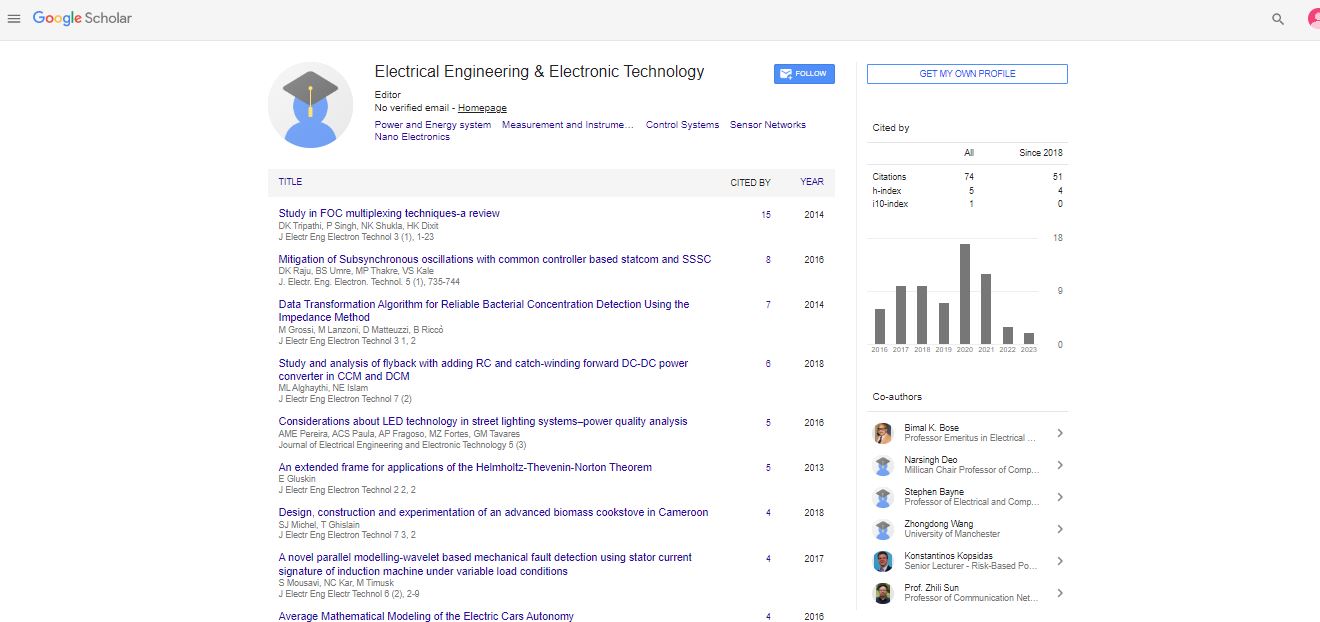Editorial, J Electr Eng Electron Technol Vol: 14 Issue: -2
Spin Engineering: Shaping the Future of Spintronics and Quantum Devices
Michael Santos*
Department of Electrical and Electronics Engineering, Ghent University,
Belgium
- *Corresponding Author:
- Michael Santos
Department of Electrical and Electronics Engineering, Ghent University,
Belgium
E-mail: santos048@gmail.com
Received: 01-Mar-2025, Manuscript No. jeeet-25-170128; Editor assigned: 4-Mar-2025, Pre-QC No. jeeet-25-170128 (PQ); Reviewed: 18-Mar-2025, QC No. jeeet-25-170128; Revised: 25-Mar-2025, Manuscript No. jeeet-25-170128 (R); Published: 31-Mar-2025, DOI: 10.4172/2325-9838.1000999
Citation: Michael S (2025) Spin Engineering: Shaping the Future of Spintronics and Quantum Devices. J Electr Eng Electron Technol 14: 999
Abstract
Introduction
In the rapidly evolving world of electronics and quantum technology, a concept known as spin engineering is gaining attention for its potential to revolutionize how we process and store information. Traditional electronics rely on the charge of electrons, but spin engineering takes advantage of another intrinsic property of electronsâ??their spin, which can be thought of as a tiny magnetic moment pointing either â??upâ? or â??down.â? By controlling and manipulating electron spin, scientists can create more efficient, faster, and energy-saving devices [1]. This new approach is the foundation of spintronics, a field that merges magnetism, quantum physics, and electronics [2].
Discussion
Spin engineering involves the deliberate design and control of materials and devices to manipulate electron spin for technological applications. The main goals include generating, controlling, and detecting spin currents, often without relying on large magnetic fields. This is achieved through advanced materials like ferromagnets, topological insulators, semiconductors, and two-dimensional materials such as graphene [3].
One of the core techniques in spin engineering is the spin injection, where spin-polarized electrons are introduced from a magnetic material into a non-magnetic conductor or semiconductor. Maintaining the spin orientation over a distanceâ??known as spin coherenceâ??is critical for the success of spintronic devices. Spin engineers use various strategies to preserve coherence, including creating ultra-clean interfaces and using materials with weak spin-orbit coupling [4].
Another important concept is spin-orbit coupling (SOC), which links the electron's spin and its motion. SOC is a key factor in designing devices like spin transistors and spin filters. It also plays a central role in new quantum materials like topological insulators, which conduct electricity on their surface with spin-momentum locking, making them highly desirable for spintronic applications [5].
Spin engineering has already shown promise in practical devices. Magnetic random-access memory (MRAM) is one commercial application, where spin-based mechanisms are used to store data more reliably and with less power than traditional RAM. In the field of quantum computing, spin qubitsâ??quantum bits based on electron spinâ??are being developed as fundamental units for processing quantum information due to their potential for long coherence times and scalability.
However, challenges remain. Achieving room-temperature spin coherence, efficient spin injection, and scalable fabrication are ongoing areas of research. In addition, integrating spin-based components with conventional silicon-based electronics requires innovative engineering solutions.
Conclusion
Spin engineering is at the forefront of next-generation electronics and quantum technologies. By manipulating the spin of electrons, researchers can design devices that are not only more efficient and powerful but also open up new functionalities unattainable by charge-based systems alone. From spintronic memory and logic to quantum computing, spin engineering holds the key to breakthroughs that could define the future of technology. As material science, nanotechnology, and quantum physics continue to converge, spin engineering will remain a vital field driving innovation across computing, communication, and beyond.
References
- Husemann B (1989) Cardia carcinoma considered as a distinct clinical entity. Br J Surg 76: 136-139.
- Edwina ED, Lydia K, Ian AY, Belinda EC (2011) Mesothelial markers in high-grade breast carcinoma. Histopathology 59: 957-964.
- Ashok R, Satish GN (2003) Insular carcinoma of the thyroid in a 10-year-old child. J Pediatr Surg 38: 1083-1085.
- Patterson SK, Tworek JA, Roubidoux MA, Helvie MA, Oberman HA (1997) Metaplastic carcinoma of the breast: mammographic appearance with pathologic correlation. R Am J Roentgenol 169: 709-712.
- Eigo O, Yoshiaki K, Daisuke I, Kazuma O, Akeo H, et al. (2005) Characteristics of gastric carcinoma invading the muscularis propria. J Surg Oncol 92: 104-108.
Indexed at, Google Scholar, Crossref
Indexed at, Google Scholar, Crossref
Indexed at, Google Scholar, Crossref
Indexed at, Google Scholar, Crossref
 Spanish
Spanish  Chinese
Chinese  Russian
Russian  German
German  French
French  Japanese
Japanese  Portuguese
Portuguese  Hindi
Hindi 
